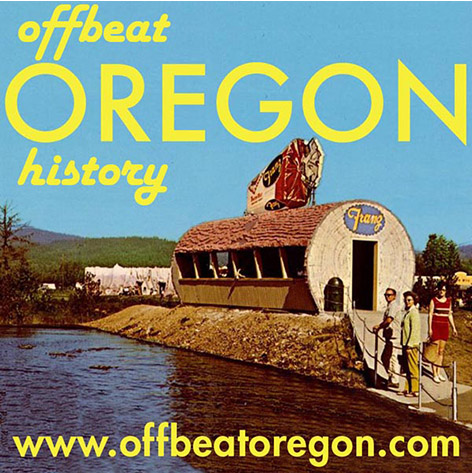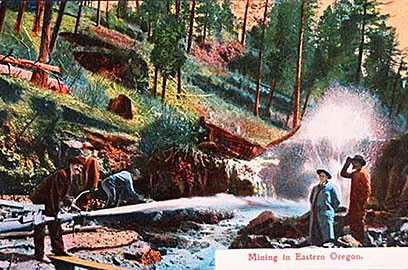
Looking for more?
On our Sortable Master Directory you can search by keywords, locations, or historical timeframes. Hover your mouse over the headlines to read the first few paragraphs (or a summary of the story) in a pop-up box.
... or ...
AUBURN, BAKER COUNTY; 1860s, 1870s, 1880s:
A long-gone gold town’s short but colorful past
Audio version: Download MP3 or use controls below:
|

At first the town was part of Wasco County, but the county seat was 300 miles away in The Dalles. Dick Pintarich writes that one miner, arrested for killing his partner in their tent, claimed self-defense, and the townspeople decided to send him to The Dalles for trial. Two men agreed to escort him there, and the townspeople advanced $50 for their expenses. The three of them then vanished, but were seen later prospecting together in Idaho — “no doubt with $50 worth of new tools,” Pintarich observes wryly. Generally, though, the murder rate in Auburn was kept relatively low by the ferociousness of what passed for justice there. That ferociousness seems to have been reserved primarily for “foreigners,” though — Frenchmen, Mexicans and Chileans. The lynching of Spanish TomThe most notorious incident in Auburn’s short history happened when a Latino man known to history only as Spanish Tom strolled into a saloon one November night in 1862, and tried to get in on a card game being played by Henry Labaree and Jack Desmond. The problem was, he had no cash to ante up, and the other two weren’t interested in Spanish Tom’s IOUs. Voices were raised, and then Spanish Tom pulled a knife, and a couple seconds later he was running out the door as Labaree and Desmond lay bleeding, dying or already dead, on the floor behind him. 
Three men, dressed rather too well for a day working in the mines, pose at the entrance of the Solomon Mine near Sumpter in the late 1800s. (Photo: Baker County Public Library collection)When Spanish Tom was recaptured a couple days later, the sheriff and justice of the peace tried to initiate the prosecution process. The two officials started making ready for a speedy trial, probably followed by an execution. The other 5,998 residents of Auburn, however, seemed not to be in a patient mood. Soon a mob surrounded the judge’s office. They weren’t here for the trial. They wanted the prisoner — now. The judge, when he saw which way the wind was blowing, grabbed his docket and ran for his life, leaving the sheriff to hold his ground — which he made a valiant effort to do. But the mob got hold of Spanish Tom’s leg iron and used it to drag him away to the hanging tree, letting his head bounce on the ground as they ran. 
Auburn as it looked in 1862 (the photo is tagged as 1861, but this is likely an error). Auburn was a haphazard, ramshackle town from the start, as the miners spent as little time as possible building and maintaining homes; time spent getting a wall square was time lost at the diggings. (Image: Oregon Historical Society)One of Spanish Tom’s friends, whose name is also lost to history, tried to put him out of his misery with a shot, but missed him and instead wounded three members of the mob. Other members of the mob gave chase as Tom’s friend ran for his life. He was too slow, and went down in a hail of bullets. Eventually the mob got Spanish Tom to the tree, and found him already dead. But they strung him up anyway. A few weeks later, the sheriff started construction on a new jail — one clearly designed to withstand siege by angry mobs. Easy come, easy goThe gold in Auburn was gone in what must have seemed like the blink of an eye. Six thousand eager miners can get a whole lot of dirt dug up and moved around, and it took them just two summers to do it. By 1864, the Salem Statesman reported that the town was all but deserted. The action had moved to other nearby towns like Sumpter and Baker City, which had more going for them than just proximity to the gold fields. Today, those gravestones are all that’s left. If you look around, you’ll find the graves of Spanish Tom’s two murder victims, and of Henry Griffin, the guy who started it all. You’ll also find plenty of anonymous graves marked only by a dip in the ground where the coffin collapsed. Like the people buried in those graves, Auburn is long gone.
|
©2008-2023 by Finn J.D. John. Copyright assertion does not apply to assets that are in the public domain or are used by permission.




